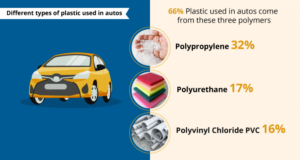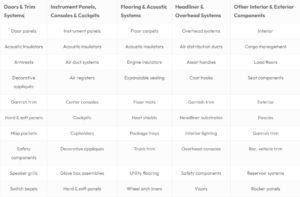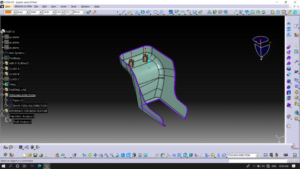Vehicles that are lightweight and fuel-efficient are largely made of plastic. It aids in the businesses’ ability to compete in the marketplace. The automotive industry is experiencing a rise in demand for plastics as a result.
We’ve gone into more detail in our blog about the reasons behind the use of plastics in manufacturing.Read Part -1
We’ll talk about plastic types and important manufacturing procedures here.
Plastic—Plastic, Plastic, and More Plastic

In automobiles, 39 distinct types of plastic are employed. A large portion of plastic is utilised in various automotive systems, such as safety elements like airbags and seatbelts, electrical systems, chassis construction, powertrains, fuel systems, and engine parts. Here is the table from the report of SPI: The Plastics Industry Trade Association.

Plastics and its Main Types
Hydrocarbons and organic materials make up plastics. They are produced by a chemical process known as polymerization, in which chains of hydrogen and carbon atoms are created by the application of pressure, heat, or other chemical reactions. Any plastic component’s physical formation results from the polymer chains’ direct or cross-linking. Granules and viscous liquid are the two forms in which plastic raw materials are offered.

The plastic materials can be broadly classified in two groups.
Thermoplastics
These materials can be found in solid state. When heat is applied, they become softer at temperatures between 150° and 300°. They can be moulded into the desired shape when they are softened (viscous liquid). After being cooled to room temperature, they can solidify. It is possible to repeat the process of softening (liquification) and solidifying multiple times.
Polyethylene (PE), Polypropylene (PP), Nylon, Polyvinyl Chloride (PVC), Polyestyrene, and Acrylic are examples of common types.
Thermosetting plastics
These substances can be bought as thick, viscous liquids or solids. Solids soften at lower temperatures and solidify at higher pressures or temperatures (approximately 250° C). Certain chemical reactions can cause materials in thick, viscous liquid form to solidify. But once such solidification occurs, heating cannot cause it to soften again. Heat application might only cause the material to burn.
Typical varieties include urea formaldehyde, hard PVC, phenol formaldehyde, melamine formaldehyde, epoxy resins, and Bakelite.
Components made of thermosetting plastic are more robust, rigid, and temperature-tolerant. Thermoplastics are used in engineering applications more often than thermosetting plastics.
Choosing Right Manufacturing process
Depending on the type of plastic, its intended use, and the necessary geometries, a wide range of plastic manufacturing processes are available. These are a few of the variables that are important to consider when selecting the manufacturing process.

Let’s now discuss a few of the most popular methods for producing plastic parts during the manufacturing process.
Blow moulding
The process of blowing heated plastic is called blow moulding. It is used to blow a heated plastic tube inside a mould to create hollow plastic parts. A heated plastic tube conforms to the mold’s desired shape. Cans, containers, bottles, and other plastic products are made using this process.
Extrusion
Fixed cross-sectional profile objects are made by extrusion. Plastic is forced through a die using this technique. This process works well for making conduits, bags, pipes, and tubes made of plastic.
Thermoforming
A plastic sheet is heated to soften and then shaped inside a mould during the thermoforming manufacturing process. After any necessary trimming, the finished product is produced. Transparent film packaging for consumer goods like toothbrushes, shaving blades, soaps, toys, dry goods, capsules, etc. is made using this technique.
Injection moulding
A manufacturing technique called injection moulding (IM) uses molten thermoplastic to be injected into a mould to create objects. It is the method most frequently used to produce plastic parts in large quantities. For intricately shaped products like automobile interiors, bags, baskets, furniture parts, utensils, cell phone and calculator bodies, presentation pieces, knobs, handles, etc., this is very helpful.
Why care about plastic design?
Given the increasing prevalence of plastic manufacturing in automotive components, it is clear that understanding these procedures will be essential for design engineers. He or she needs to be aware of the best manufacturing options that are now and will soon be accessible. By taking the Product and Tool Design Engineer course offered by G2G INNOVATION you will gain a professional understanding of plastic components from a design standpoint.
In our upcoming blog, we will discuss design considerations for plastic component manufacturing.

